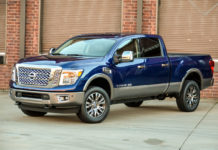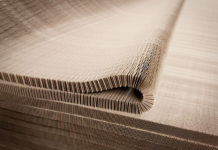With its V10 engine providing more than 600 horsepower and with an array of cutting edge technologies including a ceramic composite clutch and brakes beneath its carbon-reinforced body, you might wonder what improvements Porsche could possibly make to its Carrera GT supercar for the 2005 model year.
Well, those changes are few indeed: A glass screen mounted between the supplemental safety bars, a seat-height adjustment feature and an additional seat cushion in the thigh area, the chassis number imprinted on the magnesium cover of the center console, a battery trickle-charger included as standard equipment and new color options for both the car’s exterior and its leather upholstery.
Those small changes are all designed to further enhance the unprecedented driving experience that the Porsche Carrera GT provides to its owners.
Beautiful design and engineering, and 605 horsepower
The Porsche Carrera GT, which was introduced as a 2004 model, is a low, sleek, lightweight roadster that is as beautiful to the engineer as it is to the eye. Foul weather protection is also available in the form of two removable panels that can be stored in the front trunk.
Among the car’s unique features are its 5.7-liter, 605-horsepower (SAE) V10 engine, its monocoque chassis with Porsche-patented engine and transmission mounts made of carbon-reinforced plastic and the first use of a ceramic composite clutch in a production car. The Carrera GT’s aerodynamic and race-bred suspension package provides safe and stable travel at speeds of up to 205 mph (330 km/h). The Carrera GT features the extensive use of lightweight materials, such as magnesium for the car’s substantial wheels and the frames of its special sport seats.
The result of such artistic and athletic equipment is a car that accelerates from a standing start to 62 mph (100 km/h) in only 3.9 seconds, reaches 100 mph (160 km/h) in less than seven seconds, 125 mph (200 km/h) in less than 10 seconds, and can achieve a top test-track speed of 205 mph (330 km/h).
The marriage of form and function
The Porsche Carrera GT’s design clearly indicates its athletic abilities. Yet contrary to prototypes used only in motorsports, the Carrera GT’s design and character shows a clear link to Porsche’s production cars.
From the front, the Carrera GT bears the typical Porsche face, with an extreme, swept-back “arrow” design that rises up at the sides much like the Porsche 718 RSK Spyder racecar of the 1960s. As on the awesome Porsche 917 racecars, flat glass covers a pair of large projection headlamps that feature the most advanced and sophisticated headlight technology in V-shaped Xenon headlamp units. Just as on the Porsche 911® Turbo S, three extra-wide air intakes in the lower front fascia underscore the Carrera GT’s clear commitment to outstanding performance by providing air to cool a trio of front-mounted radiators and the ceramic front brakes.
The Carrera GT’s look is even more dramatic in profile, where its taut, stretched and sleek shoulder line comes clearly into view. A cockpit oriented clearly toward the front of the car with a long panel between the door and rear axle accents the mid-engine architecture. Exterior mirrors have V-shaped bases and match the rake of the car’s A pillar.
Airflow management a crucial consideration
Large air intakes and side outlets in front of and behind the doors add to the dynamic appearance. But, as is typical with Porsche, with form comes function; these openings are designed to ensure airflow to and from the engine, transmission, brakes and air conditioning systems. Literally “cut into” the basic design of the car, just as on an aircraft, the air intakes are part of a highly functional aerodynamic airflow surface that enhances both the Carrera GT’s athletic abilities and its aesthetic appeal.
To provide a view of the engine and to enhance cooling, cross-drilled stainless steel power domes stretch back from the rear panel behind the Carrera GT’s seats. Two supplemental safety bars just behind and above the seats reinforce the car’s dramatic design but also have a functional role beyond safety: They anchor the removable roof when it is in place over the cockpit.
At the rear of the car, a wing that spans between the tops of the fenders provides downforce for highspeed stability. To assure stability at higher speeds, the wing rises 6.3 inches (160 mm) when the car achieves 75 mph (120 km/h), thus increasing downforce by some 30 percent. The wing retracts to its normal position when the car slows to less than 50 mph (80 km/h).
A racing-style diffuser beneath the rear section of the car enhances the aerodynamic effect of the wing and also provides a visual counterbalance to the wing’s upward arc. Two stout tailpipes are integrated into the carbon fiber panel on either side of the rear license plate mount. The ribbed cover around the tailpipes is designed to enhance cooling and again reflects Porsche’s clear belief in form following function.
Underbody design an important element
Although hidden from view, the underside of the car was designed just as carefully as the Carrera GT’s beautiful and sleek body. A fully covered underfloor provides ground effects to meet the demands of high-speed aerodynamics. The under floor structure includes airflow ducts, and the rear diffuser is made of composite carbon fiber and is firmly bolted to the chassis, engine mounts and crash structure.
Carefully designed with computerized and wind tunnel evaluation, this under floor system channels air to maintain the car’s 30/70 front/rear downforce balance.
Body structure honed with motorsports heritage
Porsche’s motorsports division designed and developed the Carrera GT’s body structure. The monocoque combines all structural functions. Unlike a conventional body shell made from numerous separate components, the monocoque is made from only a few elements that are bonded together in a high-pressure furnace to form a single or mono-structure that is exceptionally rigid and strong.
Carbon fiber reinforced plastic (CFP) is the generic term for the composite fiber materials developed primarily for aerospace applications but now widely applied in motorsports vehicle construction. These materials provide supreme performance through their combination of minimum weight and maximum strength and stiffness.
On the Carrera GT, CFP is used for the chassis, which includes the windshield frame (which is reinforced by a steel core) and supplemental safety bar system, engine/transmission support frame, doors, hoods, fenders, underfloor tray and even in many interior components.
CFP is constructed from bonded layers of materials, including carbon fiber tissue, resin and aluminum or plastic honeycomb material that can be nearly an inch in thickness. Aluminum inserts are laminated at specific points so other components can be attached to the load-bearing monocoque structure.
The structure is sealed in an airtight foil cover and placed in a high-pressure autoclave furnace, where the resins form a polymer and bond the honeycomb to the carbon fiber. Such carbon bonding creates a strong, stiff and precise structure that is also resistant to temperature extremes.
Lightweight, but strong
The racing-style monocoque structure provides superior torsional and flexural stiffness and a strong anchor for the car’s body and suspension as well as an energy-absorbing and occupant-protecting shell. Because carbon components are as much as 40 percent lighter, the full Carrera GT chassis weighs little more than 220 pounds (100 kg).
The Carrera GT is the first road car built around such a chassis and also the first with an engine and transmission support made entirely of CFP, a concept developed by Porsche’s motorsports department because of carbon-reinforced plastic’s structural strength and thermal resistance.
CFP also is used in the Carrera GT’s removable roof, which consists of two lightweight panels and is held in place by rapid-action catches. The roof can be stored in the car’s front luggage compartment when not mounted above the passenger compartment.
Safe by design
The Carrera GT has steel reinforcement in its windshield structure. The longitudinal arms commonly referred to as chassis legs are made from high-strength stainless steel and help create a crash structure at the front and rear of the vehicle. Aluminum inserts connect the longitudinal arms to the chassis at the front and to the engine/transmission support frame at the rear. The bumper system is made of a strong aluminum crossbar and impact tubes.
Porsche’s development engineers placed the car’s fuel tank in an aluminum drawer within the monocoque and between the passenger cell and engine compartment.
In addition to protecting the fuel tank, the chassis is designed to protect its human occupants. The Carrera GT is equipped with three-point safety belts with pretensioners and load limiters, but the seats also are prepared to accept six-point racing belts. Passive safety equipment includes front and side airbags for both the driver and passenger. Strong steel tubes built into the Carrera GT’s doors provide additional side-impact protection.
Purebred racing engine
Porsche’s development center in Weissach, Germany, built a 5.5-liter, normally aspirated V10 engine for racing, and that engine’s bores have been enlarged to displace 5.7 liters in the Carrera GT. Maximum output is rated at 605 horsepower (SAE) at 8,000 rpm, with peak torque of 435 lb.-ft. The engine has a very low center of gravity, a 68-degree V angle and four valves-per-cylinder heads. The engine block serves as a load-bearing part of the chassis structure, yet is so strong that there is no distortion to the cylinder bores. Using dry-sump lubrication reduces the number of engine components and seals and also helps optimize weight and reliability.
To keep the engine as short as possible, Porsche engineers decided against using cylinder liners. Instead, the cylinders are coated with Nikasil, a nickel and silicon combination coating that improves wear resistance and minimizes internal friction.
The engine has a closed-deck configuration, a principle carried over from motorsports. This closeddesk architecture enables the cylinders to be cooled by internal water chambers that directly surround the cylinders. Three front-mounted radiators and cross flow cooling ensure optimum heat transfer even under high engine loads.
The engine weighs only 472 pounds (214 kg.). The block, crankshaft and camshafts are all made of light alloys.
The crankshaft is designed to operate at speeds of up to 8,400 rpm and is both forged and designed for minimum mass inertia and thus offers maximum torsional stiffness. Pistons are connected to the crankshaft by titanium connecting rods that are very lightweight. The crankcase is a one-piece unit that integrates the secondary air ducts as well as the separate bearing blocks for the camshaft. The camshaft drive is a combined sprocket/chain system with rigid cup tappets that guarantee a stiff and sturdy valve drive with low masses and compact dimensions. Porsche-patented VarioCam® Plus camshaft control provides the intake camshafts with infinite adjustment within a range of 40 degrees.
Stainless steel exhaust system
The Carrera GT has a two-chamber exhaust system with one pre-catalyst and a main catalyst on each side. The exhaust system is made of stainless steel and is precisely tuned to provide a powerful sound that includes the high-frequency roar of a thoroughbred racing engine.
Six-speed manual transmission
The engine’s power reaches the rear wheels through a specially developed six-speed manual gearbox that has compact dimensions and a low center of gravity. The transversely mounted gearbox ensures optimum weight distribution without impairing the position of the rear diffuser.
Rather than carrying the weight of a two-mass flywheel, the transmission uses a special shaft design: the first main shaft is a hollow tube housing the long and thin solid shaft. This effectively creates a torsional spring that enables the shafts to dampen drive impacts and to reduce transmission noise.
Porsche Ceramic Composite Clutch
The Carrera GT is the first Porsche to feature the Porsche Ceramic Composite Clutch (PCCC®), which is extremely compact and contributes to the car’s low center of gravity. The PCCC’s low mass also has a positive effect on engine dynamics.
Ceramic composite clutches used in racing often have short lives, but Porsche has created a new clutch design and configuration with a two-plate dry clutch with ceramics made of carbon fiber and silicon carbide that are strong, light and have an exceptional service life. The plates are only 6.65 inches (169 mm) in diameter, less than half the size of typical production car clutch plates.
Race-winning suspension design
The chassis and suspension of the Porsche Carrera GT are based on the architecture of the Porsche GT1, the car that won the 24 Hours of Le Mans race in 1998. For example, as on the GT1, the rear track control arms of the Carrera GT are made of aerodynamically designed steel tubes. However, Porsche engineers did not forget the need for driving comfort on the street when they adapted such racing-bred systems for the road-going supercar.
Like a racecar, the Carrera GT uses pushrod suspension with double-track control arms at all four corners to give the Carrera GT its refined response and behavior, feeding forces smoothly and efficiently into the car’s chassis. Where many cars use MacPherson spring struts, the Carrera GT’s spring and damper elements are operated by stainless steel pushrods and pivot levers, which separate the guidance function from the spring action. Advantages include more sensitive response and behavior as well as precise suspension tuning for both high and low speeds.
Forged aluminum control arms resting on broad mounts feed wheel forces into the chassis. As on a racecar, the control arms are bolted on the chassis without rubber insulators, providing the most precise and direct wheel guidance at all times. The Carrera GT’s superior driving dynamics are further enhanced by a power steering system that has its steering column also bolted directly to the monocoque body structure.
Porsche Ceramic Composite Brakes
The Carrera GT is equipped with Porsche Ceramic Composite Brakes (PCCB®). The cross-drilled composite ceramic brake discs are 14.96 inches (380 mm) in diameter at all four corners of the car. Those discs are 1.34 inches (34 mm) thick, yet are 50 percent lighter than comparable cast iron discs.
Porsche composite brakes provide immediate, frictionally consistent and optimized response while slowing the Carrera GT. Maximum brake power is built up within fractions of a second, yet abrasion is kept to an absolute minimum and the brakes have a substantial safety reserve even under extreme loads.
Six-piston monoblock aluminum brake calipers front and rear are brand new and feature extremely large and firmly bolted connections to the wheel mounts, giving the driver outstanding feel through the brake pedal. Short stopping distances are ensured by the hydraulic brake servo that builds pressure very quickly and efficiently.
Antilock braking and traction control serve to improve dynamic driving behavior even in transitional road surfaces and in inclement weather. The Carrera GT has four-channel anti-spin control (ASC) geared specifically for its ceramic brakes to provide short stopping distances with strong steering control. ASC is activated when required throughout the car’s entire range of acceleration, limiting excessive wheel spin on the drive wheels and thus lowering instability at the rear of the car.
ASC can intervene in engine management to reduce power to the degree required. While they are spinning, the drive wheels are slowed by automatic brake differential (ABD) technology. However, the driver can switch off the traction control function by pressing a button on the center console.
Five-spoke magnesium wheels
The Carrera GT rides on large, five-spoke wheels that are the first production car application of forged magnesium rims made from a special manufacturing process that enhances strength while reducing weight. The forged magnesium wheels are some 25 percent lighter than cast aluminum wheels and thus reduce unsprung weight to a new level. The result is supreme traction as well as smooth and sure spring and damper action.
The wheels are 19 inches in diameter and 9.5 inches wide for the front of the car and 20 inches in diameter and 12.5 inches wide at the rear. The wheels feature motorsports-style central wheel locks on their hubs.
Special tires were developed for the Carrera GT. They measure 265/35 X 19 in front and 335/30 X 20 in the rear. The tires are Z rated and have outstanding grip and consistent behavior at high speeds, yet have a relatively low level of wear for such high-performance tires.
Functional ambience is interior theme
Even with its racing-quality performance, the Porsche Carrera GT has a cockpit characterized by functional ambience and the extensive use of high-tech materials. Carbon, magnesium and leather dominate interior materials, with composite components either in their natural state or painted to match the magnesium pieces.
The car’s center console is made of composite materials covered in galvanized magnesium. The shift lever is positioned about halfway up the console directly next to the steering wheel. The shift lever has a ball-shaped knob made of lightweight stratified birch/ash wood meant to remind drivers of the balsa wood shift knob in the 1970 Le Mans-winning Porsche 917.
The 2005 Porsche Carrera GT features a new seat design. The seats are finished in smooth leather and have manual adjustment because power motors would add unnecessary weight. The seats are made of a composite carbon shell. Each seat weighs only 23.6 pounds (10.7 kg.), compared to 44.1 pounds (20 kg.) for the seats in a typical Porsche 911.
Air conditioning is optimized for weight and the car comes with a standard air filter system. Even though the Carrera GT is a serious performance car, it can be equipped with many comfort features, including a navigation system and Bose® audio
Luggage matches interior color
The Carrera GT comes with its own five-piece set of leather luggage matched to the car’s interior colors. Each piece of luggage is designed for a precise place within the car: the clothes bag fits behind the passenger’s seat, the attaché case fits in the passenger’s foot well, the shoulder bag fits between the passenger’s seat and door, a center console bag fits beneath the console and there are leather bags in special storage boxes within the doors and a travel bag in the luggage compartment.
The luggage compartment is lined with a checkered fabric and can hold 2.68 cu.-ft. (76 liters) of cargo. Special leather straps hold the two roof panels in position when they are in the compartment.









